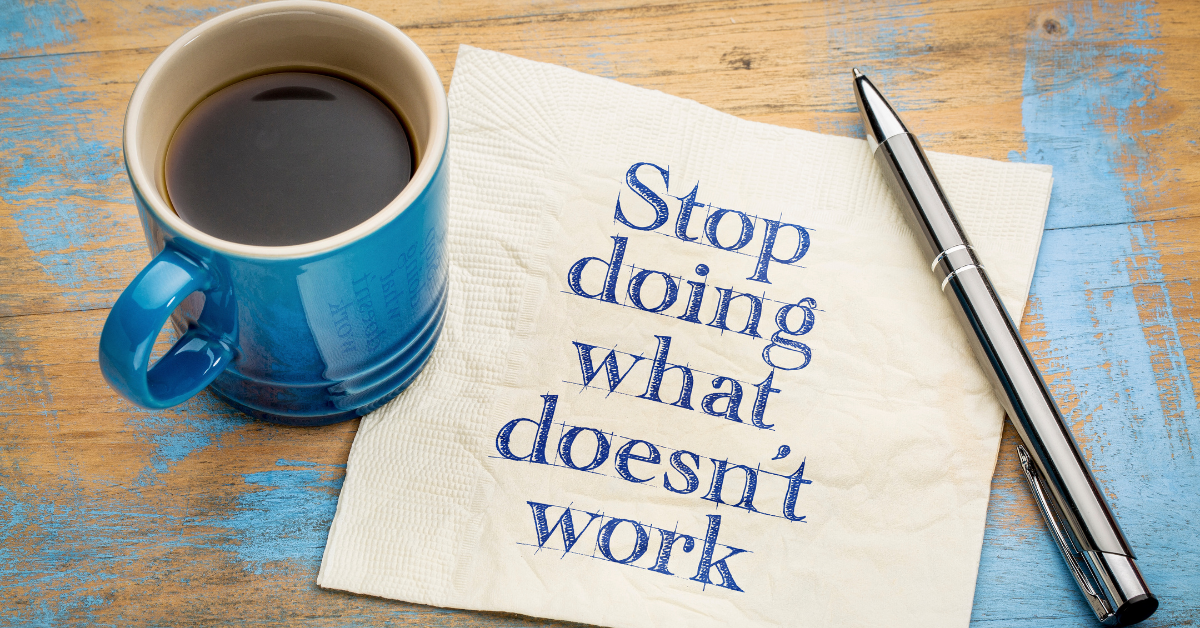Sometimes you just have to step back and examine the bigger picture. Stepping back can present opportunities to explore you may otherwise have missed.
It may seem like a simple concept, all the same, but as simple a concept as it sounds, it is very important! When we pull ourselves out of our day-to-day routines to take a broader view, new opportunities for mastery and growth are created.
We’re reminded to work “on” our business more than “in” our business because we need to have that higher-level perspective. Shifting perspective keeps us on top of changes in our industry, observant of the changing needs of our clients and able to be more visionary and strategic.
Most interactions can benefit by putting yourself in someone else’s shoes. Although many teams are back in the office, there are still many who remain online or in a hybrid structure. It is important to take a step back and understand how to optimize the online teams. The best way for team leaders to do this is to put themselves in the shoes of those they are leading.
In this blog post, we’ll be sharing a few ways to change perspective as well as a real-life example from NexLevel founder Tara-Lee. 
When the mindset of a business is shifted, it can help team leaders get a better understanding of different situations. This practice is easier said than done. The first step is identifying what might be holding the business back from success. Here are a few additional ways to change your perspective.
Learn from the mistakes
Failures lead to more learning opportunities than successes. These business failures need to be turned into the foundation of growth. Aim to get out of your comfort zone. Comfort holds back potential achievements. By staying calm after a mistake and learning from it, better long-term decisions can be made.
Stop hating Monday mornings
Instead of spending Sundays dreading the next day, focus on the positive! You’ve just rested all weekend, head into the week with a fresh perspective and positive attitude. When the week begins with bad emotions, tasks and situations will feel heavier.
Stepping Back doesn’t mean living in the past
Don’t sweat the small stuff. Learn to let go! Short-term failures happen to many organizations. Holding onto failures can make our work and personal lives difficult. Unfortunately, we can’t control everything. So if you cannot control it then it deserves to be set free from your mind. Don’t let short-term failures consume you.
Measure your success by looking forward
It can be hard to take a moment and acknowledge the little accomplishments. Take the time to write down your achievements from the day and write down your goals for the next twelve months. Get strategic and plan how you will achieve them. Refer to your list often and adjust accordingly. As you cross tasks off your list and think of new ideas, you’ll have a better perspective on your business.
Making stepping back a continuous practice
Investing time and energy into social interaction changes the brain and should enhance perspective-taking. The more you practice this, the easier it will get and the stronger you will be at changing your perspectives.
A few ways to practice include reflecting on specific examples of perspective-taking and sharing them with teammates. Another exercise is visualizing potential future situations where it might be beneficial to shift your perspective. One activity that could be beneficial as well, is drawing out scenarios. The exercises should be repeated regularly.
Take a slow and steady approach
A metaphor for running a successful business is to think of it as a marathon. When running a marathon, you might need to slow down, you might trip and fall, but everyone finishes one step at a time! Team leaders need to push their coworkers toward the finish line one step at a time. Don’t try and sprint to get ahead – burnout is more likely to occur, team members could be confused about their tasks, and work might not get done properly.
Real-life Insight from Tara-Lee
NexLevel founder Tara-Lee gives her insights and a real-life example of perspective shifts from her point of view below.
As such, I’ve found people with a “perspective practice”—the habit of strategically considering new perspectives in their daily life—tend to be calmer, more confident, and more in control.
So how can we get there?
One simple hack is to change our focus from our present experience to our journey over time.
One example: I’ve been working with an executive team on a strategy and culture transformation.
Recently, in one of many meetings on the subject, we spent a whole morning exhaustively reviewing each person’s new goals. By lunch, we were running behind, but decided to stick with the team activity we’d planned: each person would briefly share a crisis they’d faced (personal or professional), how they responded, and their reflections on it now.
As I explained the activity, the exhausted executives’ faces said, “we have so much to do today—do we have to do… this?” (Indeed, perspective practice is often most helpful when it feels least useful!)
Luckily, the team humoured me. As they revealed their crises faced, strengths forged, and perspectives gained, the energy in the room started to shift. When we dove back into their goals, exhaustion morphed into new energy… from just 20-minutes of perspective practice.
Stepping back in order to move forward – In Summary
When we’re battling so much in the present, it’s counterintuitive to turn to the past. But under stress, humans tend to lose track of what we already know. And each time we practice perspective, we begin to see more of who we are, who we are becoming, and who we want to be.
Sometimes, stepping back is the only way to move forward: uncovering timely insights we’d have otherwise missed; remembering how we overcame past challenges; and (perhaps most important) recognizing what we’re enduring could soon become one speck in the big, bright, shining constellation of our life.
A great article on Forbes on How Stepping Back can lead to Business Growth
Not sure what to do? Contact NexLevel today for a FREE Organizational Health Check to find out where you are now and what simple steps can help you be better prepared for the storm ahead.




